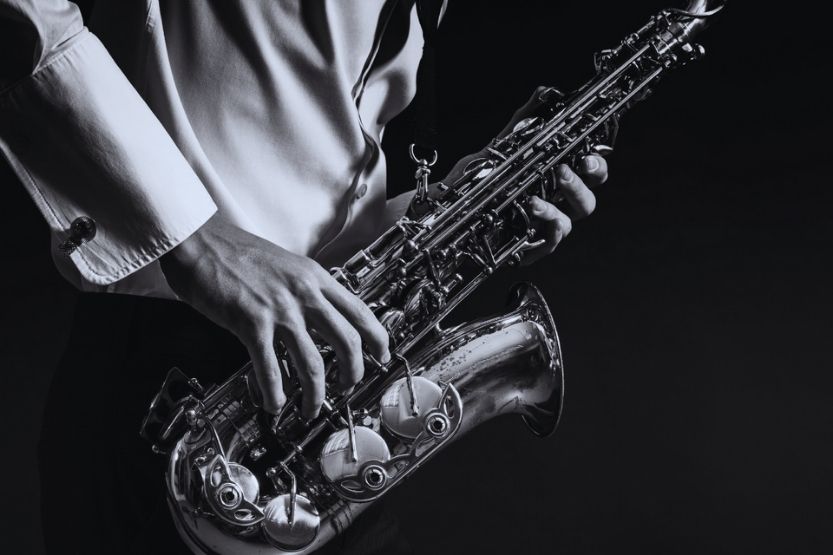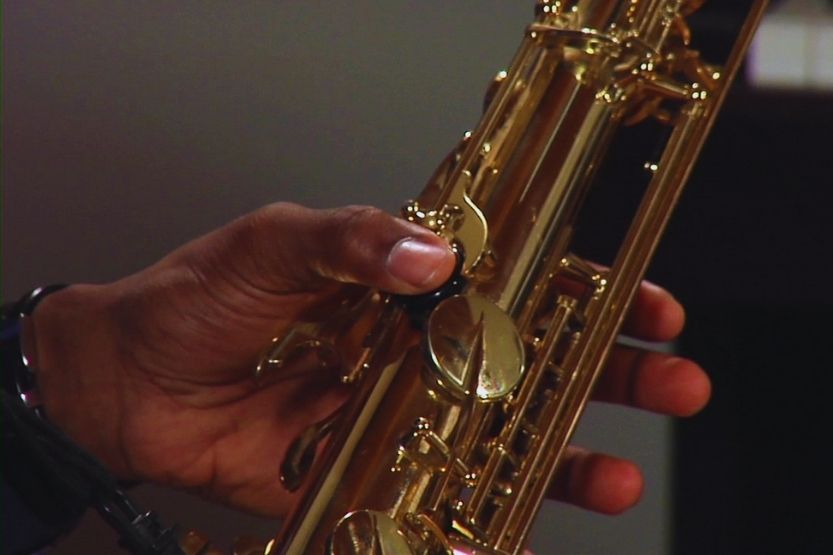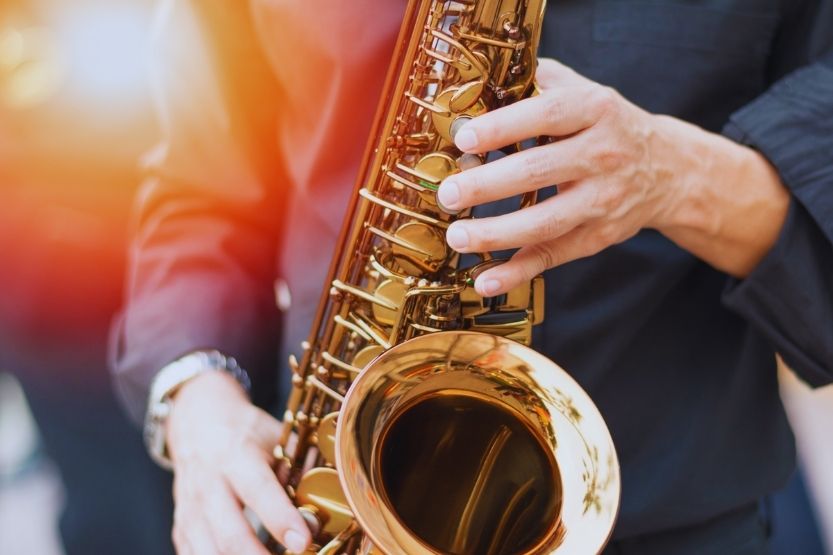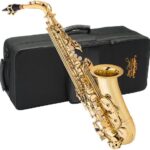Are you thinking of buying a beginner saxophone because you want to learn how to play a new instrument? Then you may want to compare tenor sax vs. alto sax first. What are the differences between the alto vs tenor sax?
The biggest and most obvious difference between the alto and tenor saxophones is their size. The tenor is a bit larger and heavier, while the alto saxophone is more diminutive. The latter is also lighter and easier to use for beginners. Because of its smaller size, the alto saxophone is capable of higher notes than a tenor.
Read on to learn more about the differences between alto and tenor sax and how to know which one is best for you.
Also, we hope you find the links here useful. We may get a commission if you purchase something through a link on this page, so thank you!
What Are the Differences? – Alto Vs Tenor Sax

There are four major types of saxophones:
- Soprano
- Alto
- Tenor
- Bass
Among the four, the favorites among professional and amateur musicians have always been the alto and tenor. While both saxophones are prevalent in popular and mainstream music, there are significant differences between the alto and tenor saxophones.
Both the Alto and Tenor Sax Are Transposing Instruments
Both the alto and tenor saxophones are transposing instruments. This means when you play a written note using them, the resulting sound will be different. For instance, if you play a C, it will sound like a Bb. These instruments also produce sounds that are distinctly different compared to pianos and other instruments with concert pitches.
Size Affects Tones
However, the size of the instrument will also affect how they will produce tones. You will see that in sheet music, the pitch designated for the alto and tenor saxophones are written differently from the other instruments. The reason is their transposing nature. A song in the key of C would sound different when played on an alto or tenor saxophone.
Tenor Saxophone Is Larger
Size is the most apparent difference between the two. The tenor saxophone is a bit larger than the alto, but the latter is easier to manage than the former. The shapes of these two saxophones are also slightly different. The neck of the alto saxophone curves up slightly at the end while that of a tenor bends slightly downward.
Alto Produces Higher and Brighter Notes
Because of the size difference, the sounds that these two instruments make are significantly different from each other. Because the alto is smaller, it can produce higher and brighter notes compared to the tenor. On the other hand, the tenor saxophone produces mellower notes, richer and deeper sounding.
Beginners Would Be More Comfortable Playing Smaller Saxophone
Professional musicians can easily get a wide array of sounds from both saxophones. However, a beginner who’s just starting to learn how to play the instrument may find it challenging to do so with a bigger instrument.
This is especially true for young kids with smaller hands and lung capacities compared to adults. It is the reason why they would be more comfortable playing the smaller alto saxophone.
Alto Saxophone Is an E-flat Instrument
Even though the fingerings and embouchure of the alto and tenor saxophones are somewhat similar, they have significant differences in how they register the notes. For example, the alto saxophone is an E-flat instrument. This means if you play a C-note, it will sound like an E-flat.
On the other hand, the tenor saxophone registers note an octave lower. This means, on sheet music, the C for a tenor saxophone sounds like a B-flat. It seems like a huge difference between the two saxophones. However, you will only notice it when you try playing a piece for a tenor saxophone on alto and vice-versa.
Tenor Saxophone Is More Expensive
Because the tenor is the bigger saxophone, it is understandable that it is much more expensive than the alto. However, the jump in price from alto to tenor saxophone is not a small one. The difference can sometimes be higher than several hundred dollars.
Which Is Better for Beginners? – Alto Vs Tenor Sax

Now, let’s answer the question, “Which is the best choice of saxophone for beginners?” Should you choose the alto or the tenor saxophone?
Although the choice between alto and tenor saxophones is mostly subjective, you have to consider certain things before deciding. Many instructors believe that the size of the saxophone matters a lot, especially for beginners.
Click here to see this Mendini By Cecilio Eb Alto Saxophone on Amazon.
Younger Students Find Small and Lighter Alto Sax Easier to Use
Click here to see this Glory Professional Alto Eb SAX on Amazon.
A smaller and lighter instrument will be easier to use, especially for the younger students. This makes them easier to learn with. This is why the alto saxophone is usually the choice of instructors and their students.
Alto Saxophone Is Easier to Blow Into
The alto saxophone has a smaller and tighter embouchure, making it easier to blow into than the tenor. Even beginners who have not developed that much lung strength yet will find it less strenuous to play the alto than the larger tenor.
Click here to see this Mendini by Cecilio Tenor Saxophone on Amazon.
Is It Hard to Learn How to Play the Saxophone?
Children’s Hands Are Not Big Enough to Manipulate the Controls
Again, this will be quite subjective as some people can easily learn how to play the saxophone than others. For instance, parents should not force their middle-school-aged children to learn to play the sax. The main reason is that their hands are not yet big enough to manipulate the controls. Their lungs are not also quite big enough for sustained playing.
People who know how to play wind instruments, especially woodwinds like the clarinet and bassoon, can easily switch to saxophones. It also helps that the fingering system used by saxophones is not quite as complicated to use compared to woodwinds.
Students Have to Overcome Lack of Instant Gratification
The biggest challenge that students need to overcome is the lack of instant gratification when learning to play the saxophone. It will take quite a long time and effort before you can even play one song somewhat well. After just a month or two, many students quit because they still can’t play their saxophones like professional musicians.
Here’s one thing that you need to keep in mind. College students who major in music and have played the saxophone for years are still discovering things.
Alto vs Tenor Sax – what’s the difference between the two? Size is the most apparent difference between alto and tenor saxophone. The Alto saxophone is smaller, and therefore produces higher and brighter notes than tenor sax. Due to its size, alto sax is also more fitting for beginners.
Is There an Easier Way to Learn How to Play the Saxophone?
1. Work on Your Fundamentals
Unfortunately, there are no shortcuts to learning how to play the saxophone. You have to work on your fundamentals first. You will not get good just by playing the same songs repeatedly.
It is crucial to work on your embouchure, practice playing scales, dynamic control, vibrato, articulation, and many more. All those are necessary if you want to become a skilled sax player one of these days. To help you get started on the right track, you should heed these pieces of advice.
2. Pick the Right Equipment
If you are serious about playing the saxophone, start by getting quality equipment. By that, I mean steering clear of the cheap, “value” instrument brands. It is always best to purchase your instruments from known brands. The brand should have proven track records in terms of craftsmanship, sound quality, and more.
Now, if you cannot afford brand new saxophones, there is no shame in buying second-hand instruments. It is always better to have a used saxophone from a known brand than a brand-new one from a maker you haven’t heard of before. We will be discussing more of the merits of buying second-hand later.
3. Practice Whenever You Can
You can learn the basics from online video tutorials. You may also want to hire a professional instructor to teach you. However, remember that all those will be for naught if you don’t practice and work on your skills. Set aside a couple of hours every day to practice playing your saxophone.
4. Get Feedback on Your Playing Style
It is also best to have a friend or acquaintance who plays the saxophone professionally. That way, you can get feedback on your playing style. You will also know what aspects of your playing you still need to work on.
Should You Get a New or Used Alto or Tenor Saxophone?

This is one of the biggest decisions that you will need to make when shopping for a saxophone. Many beginners mistakenly think about buying a used instrument. However, if you have a limited budget, buying second-hand might be the best way to go about it.
Pros of Buying a New Saxophone
1. Has a Lot of Curb Appeal and Is Ready to Use
A brand new saxophone will be ready to play as soon as you take it out of its box. Moreover, the plating and lacquering of the pieces are all still in mint condition. You can also be sure that it will have modern mechanisms, making it a pleasure to play.
2. Still Comes With a Warranty
Another nice thing about buying brand new is that you have confidence in the manufacturer’s warranty. Should anything happen to your saxophone, and it is not your fault, then you are eligible for free repairs. Some even offer a replacement or refund for such cases.
3. It Feels Good to Play a New Instrument
There is a certain psychological effect in knowing that you are playing a new saxophone. This can be quite a big deal for the younger beginners. For them, it’s about the looks of the saxophone, not how it sounds.
Cons of Buying a New Saxophone
A New Saxophone Can Be Expensive
This is especially true if you are getting a tenor saxophone. The resale value of modern saxophones also immediately bombs once you start to use them. You can probably get a decent used saxophone for a small fraction of the cost of a brand-new decent saxophone.
Mass-produced Saxophones Have Varying Degrees of Quality
You would think that mass-produced instruments would pretty much be the same quality throughout. However, in mass production, the artistic nature of making something out of nothing seems to be lacking. Everything goes through a robot assembly line, which makes them seem like they lack soul.
Pros of Buying a Used Saxophone
Quite Cheap
Regardless of your budget constraints, you will find a used saxophone that you can afford.
Older Saxophones Usually Use Better Materials and Have Lots of Craftsmanship
“They certainly don’t make them like they used to” is a term that gets thrown around in common conversations. However, it is true when used regarding saxophones.
Saxophones made during the 1970s and 1980s usually have more engraving and are likely hand-assembled. This gives them superior quality compared to most mass-produced instruments these days.
Cons of Buying a Used Saxophone
Not Knowing a Used Saxophone’s Real Worth
If you don’t do your research, then you’re at the mercy of the person selling the used saxophone. I am not saying that everyone selling used instruments take advantage of buyers. However, it would be better to be on the safe side.
Likely to Not Be in Perfect Condition
Keep this in mind, especially when you have a limited budget and can only afford decades-old saxophones from pawnshops. However, some companies sell refurbished saxophones and other old instruments, usually at competitive prices.
Conclusion – Alto Vs Tenor Sax
The most obvious difference between the alto and tenor saxophones is their sizes. The tenor saxophone is a bit larger, heavier, and shaped differently from the alto saxophone. The bigger tenor saxophone also plays mellower, deeper notes than the alto saxophone’s brighter and lighter sounds.
If you’re thinking of learning how to play the saxophone, start with the smaller alto saxophone. The main reason is that it is smaller and easier to manipulate. However, you can also give the tenor saxophone a try if it is more in sync with your playing style.
Related reading:
Chaconne Vs Passacaglia – What Is the Difference Between Them?
Euphonium Vs Baritone – What Are the Differences?
Cello Vs Bass – What Are Their Differences?









![Read more about the article Easy Clarinet Songs [Top 10 Easiest]](https://musicalinstrumentpro.com/wp-content/uploads/2021/10/Easy-Clarinet-Songs-300x200.jpg)

![Read more about the article Different Types of Saxophones [4 Most Common and 6 Less Common]](https://musicalinstrumentpro.com/wp-content/uploads/2020/11/how-many-types-of-saxophones-are-there-300x200.jpg)